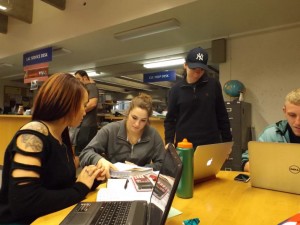Which comes first: the student or the athlete?

Sports Editor
Hudson Valley has rules put into place that prevents its student athletes from becoming academically ineligible and every year it seems that athletes slip through the cracks and put their whole teams in jeopardy. Is the system good enough? Or is Hudson Valley going to repeat this trend because it’s an institution used by good athletes with bad grades?
In order to be academically eligible, an athlete needs to have a GPA of 2.0 or higher. To help the player achieve this goal, the school has an athletic retention program, known as the “start” program. Each coach decides the number of hours their players have to put in, but it’s mandatory for each athlete to have a certain number of hours they need to spend in the library or with a tutor in order to play.
For the football team, coach Mike Muehling’s system requires each athlete to spend at least six hours a week studying in the library and working on academics. Every year, the team loses between 10-20 players for their final game because of the timing of the midterm grades being released. There is a system put in place, but it’s up to the athletes to hold up their end of the bargain.
“We have class checks and have teachers fill out progress reports,” said Muehling. The coaching staff preemptively tries to get a grasp on who is in academic trouble way before the grades come out. Muehling and his staff try to prevent their players from missing games, but at the end of the day, it’s on the athlete to be a student.
In some cases athletes who are academically ineligible one year will come back the next year and try to lead by example. “We’ve had second year players that were ineligible that came back the next year and speak to the team and help them learn from their mistakes,” said Muehling.
Athletes check into the Learning Assistance Center downstairs in the library and are required to do schoolwork for a couple hours at a time. While checked in, the athletes have the choice of seeing a tutor, using a computer or sitting on a study table to work on their assignments. Since there isn’t enough personnel to keep tabs on everybody, it is an honor system on whether the athlete does school work or just shows up to kill time.
“If I notice someone not working on schoolwork I won’t sign their timesheet,” said Don Frament, tutor in the LAC. “It’s an absolute good faith policy that you tell me that you’re studying.”
Whether the athletes cheat the system or not, Frament believes that it is a good system. “We know it impacts the students,” said Frament.
Athletes that were enrolled in the start program who took it seriously have went on and become tutors for the LAC. “I’ve had three or four different players from different teams become tutors for me,” said Frament. “There’s that connection down here to know how to become really good students and be able to become tutors.”
Other coaches take different approaches on how handle the student part of their athletes. “All 1st semester freshmen have to get five hours of study hall a week and any player who does not have over a 3.0 has to as well. After the first semester and thereafter any player from a 3.0 to 3.49 needs 2 hours and anyone with a 3.5 to 4.0 doesn’t need to go,” said Men’s Basketball head coach Mike Long.
Long has a smaller number of players to monitor so he doesn’t use the blanket system that the football team has. In terms of how the school handles its academic policy Long says, “I think the people here at HVCC do the best they can to keep the coaches informed. Progress reports at different times during the semester certainly are a big plus but that is up to us coaches to get done.”
The system certainly can be tweaked, but it’s ultimately on the players themselves if they want to be just as much of a student as they are an athlete.
